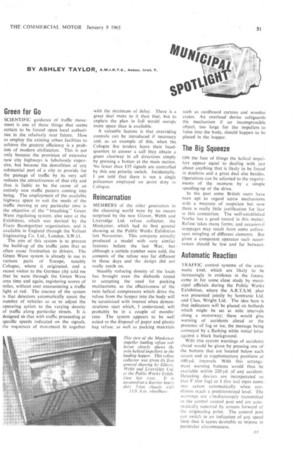BY ASHLEY TAYLOR,
Page 53

If you've noticed an error in this article please click here to report it so we can fix it.
A, Assoc. Inst. T.
Green for Go
SCIENTIFIC guidance of traffic movement is one of those things that seems certain to be forced upon local authorities in the relatively near future. How to employ the existing urban facilities to achieve the greatest efficiency is a problem of modern civilization. This is not only because the provision of extensive new city highways is fabulously expensive, but because the demolition of any substantial part of a city to provide for the passage of traffic by its very self reduces the attractiveness of that city and thus is liable to be the cause of an entirely new traffic pattern coming into being. The employment of the available highway space to suit the needs of the traffic moving at any particular time is the objective of the "breathing Green Wave regulating system, also seen at the Exhibition, which was devised by the Franz Baumgartner organization, and is available in England through the Valiant Engineering Co. Ltd., London, S.W.11.
The aim of this system is to prevent the build-up of the traffic jams that so often cause frustration to drivers. The Green Wave system is already in use in various parts of Europe, notably Cologne, where it originated, and a recent visitor to the German city told rue that he went through the Green Wave area time and again, registering scores of miles, without ever encountering a traffic light at red. The essence of the system is that detectors automatically count the number of vehicles so as to adjust the operating action to the varying density of traffic along particular streets. It is designed srlsr that with traffic proceeding at specific speeds indicated on the signals, the sequences of movement fit together with the minimum of delay. There is a great deal more to it than that, but to explain the plan in full would occupy more space than is available.
A valuable feature is that overriding controls can be introduced if necessary and, as an example of this, when the Cologne fire tenders leave their headquarters to answer a call they obtain a green clearway in all directions simply by pressing a button at the main station. No fewer than 135 signals are controlled by this one priority switch. Incidentally. I am told that there is not a single policeman employed on point duty in Cologne.
Reincarnation
MEMBERS of the older generation in the cleansing world were by no means surprised by the new Glover, Webb and Liversidge Ltd. refuse collector, the Musketeer, which had its first general showing at the Public Works Exhibition last November. This company actually produced a model with very similar features before the last War, but although a certain number were sold, the contents of the refuse was far different in those days and the design did not really catch on.
Steadily reducing density of the loads has brought even the diehards round to accepting the need for packing mechanisms, so the effectiveness of the twin helical compressors which drive the refuse from the hopper into the body will be scrutinized with interest when demonstrations start which, I understand, will probably be in a couple of months' time The system appears to be well suited to the disposal of paper and plastic bag refuse, as well as packing materials such as cardboard cartons and wooden crates. An overload device safeguards the mechanism if an incompressible object, too large for the impellers to force into the body, should happen to be placed in the hopper.
The Big Squeeze
ON the face of things the helical impellers appear equal to dealing with just about anything that is likely to be found in dustbins and a great deal else besides. Operations can be adjusted to the requirements of the moment by a simple speeding-up of the drive.
In the past some British users have been apt to regard screw mechanisms with a measure of suspicion but now there is really little justification for fear in this connection. The well-established Norba has a good record in this matter. Refuse takes many forms, and occasional stoppages may result from some unforeseen mingling of different elements. But given a competent operator such occurrences should be few and far between.
Automatic Reaction
TRAFFIC control systems of the automatic kind, which are likely to be increasingly in evidence in the .future, came in for some close study by municipal officials during the Public Works Exhibition, where the A.R.T.S.M. plan was presented jointly by Sontranic Ltd. and Chas. Wright Ltd. The idea here is that indicators will be placed oh bollards which might be set at mile intervals along a motorway; these would give warning of accidents ahead or the presence of fog or ice, the message being conveyed by a flashing white initial letter against a black background.
With this system warnings of accidents ahead would be given by pressing one of the buttons that are located below each screen and at supplementary positions at 440-yd. intervals. With this arrangement warning buttons would thus be available within 220 yd. of any accident. Detecting devices are incorporated so that F (for fog) or I .(for ice) signs come • into action automatically when conditions reach a predetermined level. The warnings are s'multaneoosly transmitted to the central control post and are automatically repeated by screens forward of the originating point. The control post can switch in an indication of any speed limit that it seems desirable to impose in particular circumstances.




















































































































